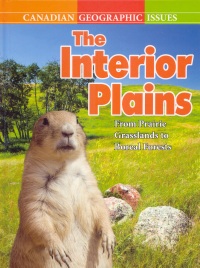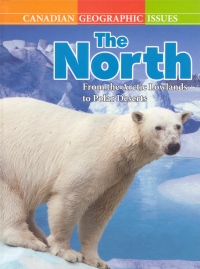| ________________
CM . . .
. Volume XXI Number 29 . . . . April 3, 2015
excerpt:
The seven titles in the “Canadian Geographic Issues” series (The Appalachian, The Canadian Shield, The Cordillera, The Great Lakes, The Interior Plains, The North, The St. Lawrence Lowlands) were originally published almost ten years ago. They describe the features of each unique landscape and explore the debatable issues that each faces. The Interior Plains focuses on the centre of Canada where there are “flat or gently rolling fields” due to glacier movement millions of years ago. They account for 18 percent of Canada and include the prairies, the boreal plains, and the taiga plains. A coloured, labelled map of Canada’s geographic regions gives readers an understanding of the location within North America. Following the double page spread map, there is information about how inland seas, mountains, and glaciers formed the Interior Plains unique landforms (Cypress Hills, Badlands) and its natural resources such as oil and gas. There are facts and charts of how the climate differs from the West Coast of Canada because of the Rocky Mountains (average temperature, average snowfall, growing season), and why the Interior Plains contains “some of the best farming soil in the world”. In the section about animals that live in the Interior Plains, the author focuses on large herbivores, waterfowl, and lists several smaller animals that live in the area, such as coyotes, badgers, and red foxes. There are paragraphs about a geologist’s and a cartographer’s job duties and education, and a 10 question quiz (with answer key) about the Interior Plains. Back materials includes an experiment about sediment, a glossary of key words, an index, and a small updated bibliography that includes books and websites. The author also provides more detailed information in sidebars that appear on almost every page of this book. Debates about fertilizer use, the Alberta oil sands, and logging occur here, as does a close-up of scientist Joseph Tyrrell. Fun facts, such as “prairie is the French word for meadow”, and the weight of the heaviest hailstone that fell in the area, can be found bordering the main paragraphs as well. One to three labelled photographs of the land appear in every two page section, and cartoon clipart appears next to the facts. The North follows along the same format as The Interior Plains, but the debatable issues the author includes concern shipping traffic, diamond mining, and global warming. It also differs because there is a section on plants in the area, and the career focus is on geophysicist and climatologists. The brief chapters contain information on the waters of the north (Arctic Ocean, Beaufort Sea), islands of the north, fossils, and permafrost. Sidebar information is about the Inuit, the Arctic Cordillera and facts about glaciers, and weather. The authors should have included a female in the career photographs, but I would still recommend these book for public and school libraries in Canada because they teach and inform children about areas in their own country. They would be useful for school projects on the provinces or for children curious about Canada’s geology. Recommended. Tanya Boudreau is a librarian at the Cold Lake Public Library in Cold Lake, AB.
To comment on this title or this review, send mail to cm@umanitoba.ca.
Copyright © the Manitoba Library Association. Reproduction for personal use is permitted only if this copyright notice is maintained. Any
other reproduction is prohibited without permission.
CM Home | Next Review | Table of Contents for This Issue - April 3, 2015 | Back Issues | Search | CM Archive | Profiles Archive |

